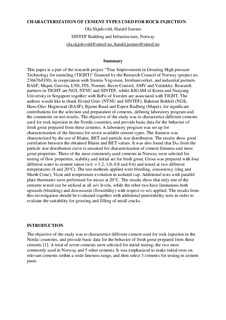| dc.description.abstract | This paper is a part of the research project “True Improvement in Grouting High pressure Technology for tunneling (TIGHT)" financed by the Research Council of Norway (project no. 236676/O30), in cooperation with Statens Vegvesen, Jernbaneverket, and industrial partners BASF, Mapei, Geovita, LNS, ITS, Normet, Bever Control, AMV and Veidekke. Research partners in TIGHT are NGI, NTNU and SINTEF, whilst KIGAM of Korea and Nanyang University in Singapore together with BeFo of Sweden are associated with TIGHT. The authors would like to thank Eivind Grøv (NTNU and SINTEF), Bahman Bohloli (NGI), Hans-Olav Hognestad (BASF), Bjarne Ruud and Espen Rudberg (Mapei), for significant contributions for the selection and preparation of cements, defining laboratory program and the comments on test results. The objective of the study was to characterize different cements used for rock injection in the Nordic countries, and provide basic data for the behavior of fresh grout prepared from these cements. A laboratory program was set up for characterization of the fineness for seven available cement types. The fineness was characterized by the use of Blaine, BET and particle size distribution. The results show good correlation between the obtained Blaine and BET values. It was also found that D95 from the particle size distribution curve is unsuited for characterization of cement fineness and most grout properties. Three of the most commonly used cements in Norway were selected for testing of flow properties, stability and initial set for fresh grout. Grout was prepared with four different water to cement ratios (w/c = 1.2, 1.0, 0.8 and 0.6) and tested at two different temperatures (8 and 20°C). The test methods applied were bleeding, consistency (ring and Marsh Cone), Vicat and temperature evolution in isolated cup. Additional tests with parallel plate rheometer were performed for mixes at 20°C. The results show that only one of the cements tested can be utilized at all w/c levels, while the other two have limitations both upwards (bleeding) and downwards (flowability) with respect to w/c applied. The results from this investigation should be evaluated together with additional penetrability tests in order to evaluate the suitability for grouting and filling of small cracks | |
